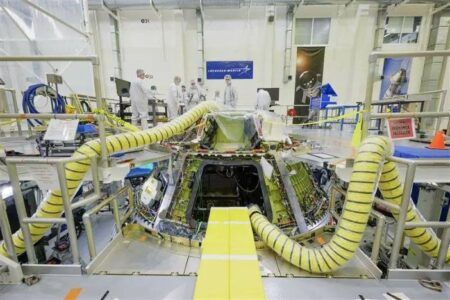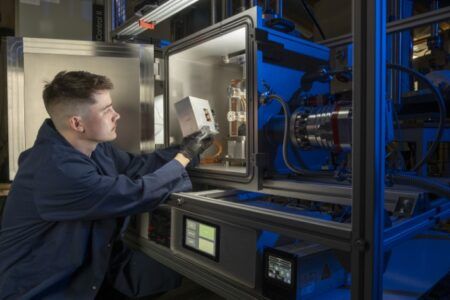A glimpse of the Deep Space Atomic Clock in the middle bay of the General Atomics Orbital Test Bed spacecraft. Image Credit: NASA
A prototype miniaturized atomic clock that will be used by future space craft for navigation is expected to be on board the next SpaceX Falcon Heavy rocket launch in April.
The Deep Space Atomic Clock (DSAC) will be part of General Atomics’ Orbital Test Bed spacecraft on the US Air Force Space Technology Program (STP-2) mission. The DSAC’s time accuracy will be tested while in orbit and if successful the technology will be used in future NASA deep space missions.
The STP-2 mission, which has been delayed from March last year, is planned to be part of the next Falcon Heavy rocket launch from the Kennedy Space Center at Cape Canaveral, Florida, on April 30.
The DSAC, which has been in development for 20 years, is a prototype of a small, low-mass atomic clock based on mercury-ion trap technology. The atomic clocks at ground stations in NASA’s Deep Space Network are about the size of a small refrigerator. DSAC is about the size of a four-slice toaster and could be further miniaturized for future missions.
The DSAC test flight will take this technology from the laboratory to the space environment. While in orbit, the DSAC mission will use the navigation signals from US GPS coupled with precise knowledge of GPS satellite orbits and clocks to confirm DSAC’s performance. The demonstration should confirm that DSAC can maintain time accuracy to better than two nanoseconds (.000000002 seconds) over a day, with a goal of achieving 0.3 nanosecond accuracy.
Navigation
In deep space, accurate timekeeping is vital to navigation, but many spacecraft lack precise timepieces on board. The DSAC instrument is being developed by NASA’s Jet Propulsion Laboratory (JPL) in Pasadena, California, and aims to provide accurate onboard timekeeping for future NASA missions.
Most NASA missions rely on ground-based antennas paired with atomic clocks to navigate. These ground antennas send narrowly focused signals to spacecraft, which return the signals. By calculating the difference in time between the sending of a signal and receiving a response, the spacecraft’s location, velocity and path can be determined.
According to NASA, there are several drawbacks to this method. A ground station can only track one spacecraft at a time and spacecraft have to wait for navigation commands from Earth rather than making those decisions on board and in real time.
DSAC principal investigator Todd Ely, at JPL, said, “Navigating in deep space requires measuring vast distances using our knowledge of how radio signals propagate in space. Navigating routinely requires distance measurements accurate to a meter or better. Since radio signals travel at the speed of light, that means we need to measure their time-of-flight to a precision of a few nanoseconds. Atomic clocks have done this routinely on the ground for decades. Doing this in space is what DSAC is all about.”
Accurate and timely location data
Spacecraft using the atomic clock technology would no longer have to rely on two-way tracking. A spacecraft could use a signal sent from Earth to calculate position without returning the signal and waiting for commands from the ground, a process that can take hours.
Timely location data and onboard control allow for more efficient operations, more precise maneuvering, and adjustments to unexpected situations. This paradigm shift enables spacecraft to focus on mission objectives rather than adjusting their position to point antennas earthward to close a link for two-way tracking.
Additionally, this innovation would allow ground stations to track multiple satellites at once near crowded areas like Mars. In certain scenarios, the accuracy of that tracking data would exceed traditional methods by a factor of five.
Once DSAC has passed its tests, future missions can use its technology enhancements. The clock promises increased tracking data quantity and improved tracking data quality. Coupling DSAC with onboard radio navigation could ensure that future exploration missions have the navigation data needed to traverse the solar system.
Technologies aboard DSAC could also improve GPS clock stability and, in turn, the service GPS provides to users worldwide. Ground-based test results have shown DSAC to be upward of 50 times more stable than the atomic clocks currently flown on GPS. DSAC promises to be the most stable navigation space clock ever flown.
“We have lofty goals for improving deep space navigation and science using DSAC,” said Ely. “It could have a real and immediate impact for everyone here on Earth if it’s used to ensure the availability and continued performance of the GPS system.”
12 February 2018




